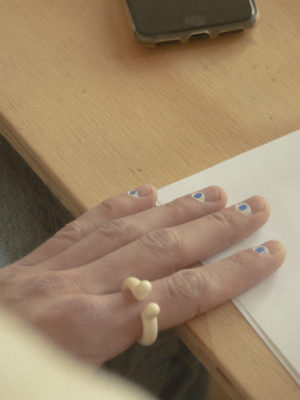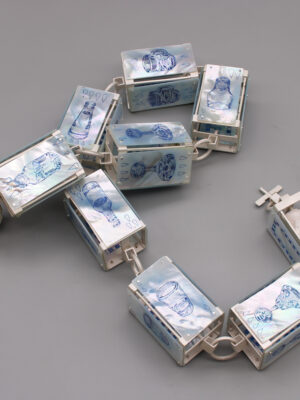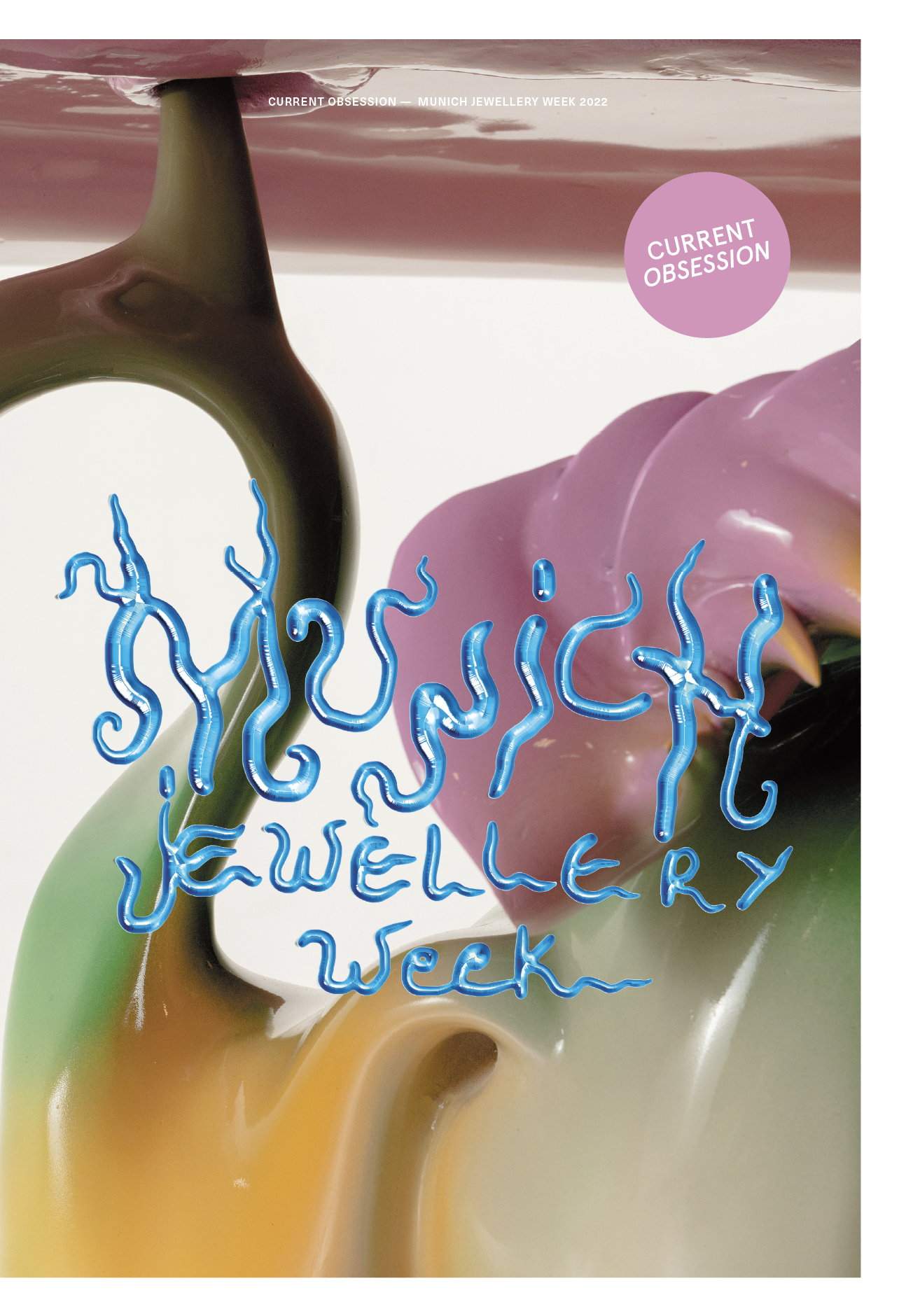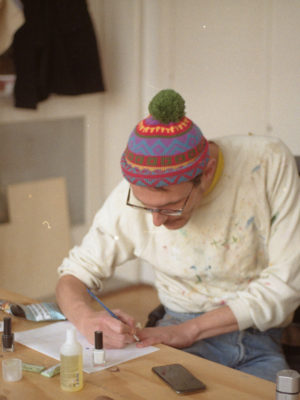
Veronika Muráriková:
You are from Austria originally. How did you settle here in Amsterdam?
Benedikt Fischer:
I think it’s because I studied here at the Gerrit Rietveld Academie, and I really enjoy the vibrant local scene. I share my studio with like-minded people and there are always events and exhibitions going on. Of course, I don´t go to every one of them – I just like the idea that I could.
Often, I have this feeling – maybe because I’m not well-integrated in Amsterdam, I haven’t perfected the language – that I should go back to Vienna, but then I wonder if I could still find the drive to go on with things. I think I already did what I could back home: I went to a technical school and learned the basic skills. I was 14 when I first started making jewellery and I always wanted to continue, but I couldn´t study it there. I considered Munich, but it felt too close to what I already knew both culturally and language-wise. I really liked the work of the Rietveld’s students, so I decided to move to Amsterdam! To be honest, I don´t really feel like an Austrian jewellery artist. When I see my name in exhibitions or publications and there is ‘NL’ behind it, I feel like, ‘Yeah, that´s correct.’ It doesn’t feel like I was raised in Austria.
At the time that you were studying at the Rietveld, Manon Kouswijk and Suska Mackert were running the jewellery department, right?
Yes, they were a dream team. Before I attended, I only realised there would be an Open Studio Day at the Rietveld two days before it happened. I had a boyfriend who was vastly supportive, so at his urging, I decided to go. I met Manon personally and enjoyed the whole atmosphere of the school. In my opinion, it was a great mix: Manon was very focused on jewellery itself, while Suska used jewellery more as a medium, but it was always at the core of everything. They could develop and reinforce each student’s talents without pushing them to do things one way or the other.
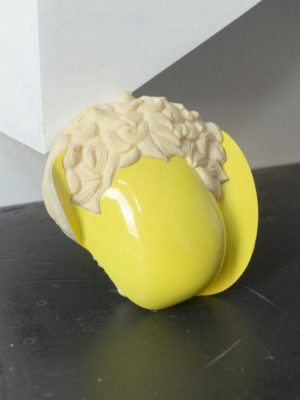
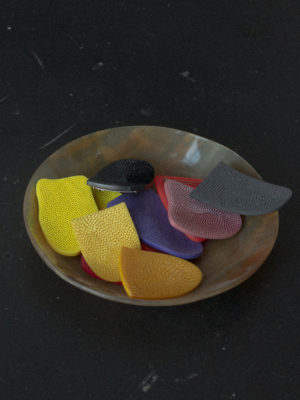
Did you have a hard time assimilating into a more conceptual way of making jewellery after your goldsmith training, or it was a rather natural process?
At the beginning, yes, it was hard. I remember when I had my interview, I was told that I had to do the Basic Year to get to know ‘the Rietveld’s way of doing things,’ which was very different for me because I’d never done ‘art’ before. I was stubborn and impatient, so for the first semester I was kind of lost and ended up struggling a bit. It took half a year for me to get used to it.
You mentioned that you always knew you wanted to make jewellery, but you were also teaching at some point, correct? How would you describe this experience?
I enjoy teaching a lot! I would do it again at the right academy. In Halle, Germany, it was challenging and very different. Teaching is time-consuming and takes a lot of focus so during my two years in Halle I didn’t work on my own pieces all that much. I guess I could have, but it was new to me and I wanted to do a good job.
Recently, I was invited to teach at Alchimia in Florence for a week, and I really enjoyed it. It’s important to be at a place where you feel that you are beneficial and can add something. At Alchimia I felt that I could teach them a divergent way of working and a new way of approaching the creative process. It’s great to be part of an academic community with whom you share the same interests and within which there is a constant and rapid exchange of ideas.
True! Many academies struggle to find the right teachers…
I think that is because teaching is one of the most plausible ways to earn money in today’s art world. So, some people who teach don’t actually like making work. In Germany, there is another problem on top of that, which is that they usually name jewellery departments as a ‘class of’ the main instructor. This immediately gives people a specific impression of the program and imposes responsibility for the whole program on that one person. Having just one teacher is like having just one parent.
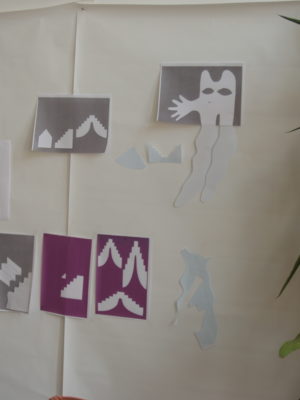
Alongside making your own jewellery and teaching, you also did collaborative projects. You designed lamps with your former schoolmate Boris de Beijer and created two rings with Goran Kling. Who else have you collaborated with?
You mean Benedikt Fischer? Yeah, I always wanted to collaborate with someone with the same name as me. A long time ago, I added several Benedikts on Facebook and ended up working with one of them. I liked him based off of his online representation. He was also doing creative stuff and was a photographer, so I just asked him if he wanted to work with me. It was really interesting starting point – to get to know a complete stranger.
What about the collaboration itself? How did it go?
The first time we met was in Vienna. We spent the whole day together, talking and going to exhibitions. He felt kind of familiar from the very beginning. I was very curious whether it meant anything that we grew up with the same name. Were there any similarities at all? After we took a photo booth picture together, some people actually thought we could be related.
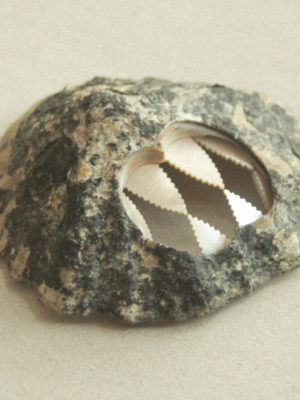
It seems that you are open to any and all inputs or impulses that might inspire you. Your latest collection Pearly Whites also came to life by chance. Please, talk me through the story of its creation.
I was commissioned to create a piece with a baby tooth and I spent a long time wondering what I should do with it. Then, when I was at home, I found four baby teeth in my mum’s drawer. I like to think that there was one from each of my three siblings and I. So, all of these teeth were laying on my workbench for some time, among various shells I collected these really long razor clams and somehow it came together. To be honest, it wasn’t really linked to any specific research, although baby teeth are often kept and are even worn as jewellery by some people.
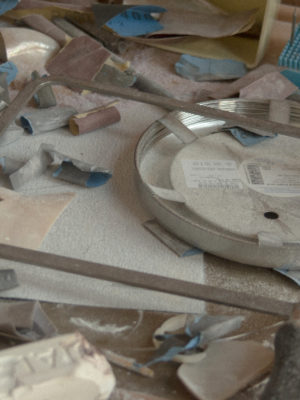
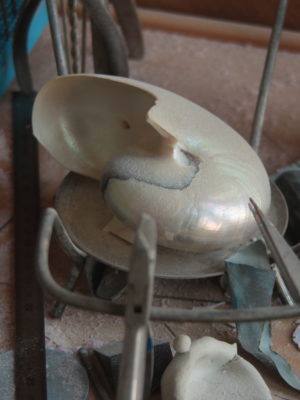
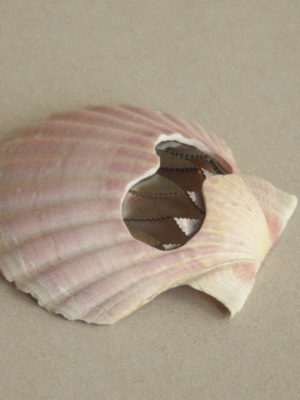
Did you collect the shells on your own?
Some of them. Of course, sometimes I also get them as presents, but there is a great shell fair in The Hague twice a year. The funny thing about that is that people come there with catalogues to compare pictures with the actual shells and deliberate whether or not they look the same and are worth purchasing for their collection. It’s very interesting…
You’ve discovered an interesting, spontaneous way of creating something new. I find this collection very successful.
Yes, it’s really popular! You can never foresee these things. For example, with the lamps you mentioned before, we thought, ‘Ah, this is going to be a huge success!’ But they didn’t end up being that huge. With Pearly Whites, I wasn’t so sure, but in spite of what I thought, they suddenly became desirable. What worked well with the collection and definitely contributed to its success were the images we took of it. They photograph well because the brooches resemble an emoji, but the shell is such a classical jewellery motif.
How is your relationship with social media and online representation?
Well, I didn´t even have a smartphone until last autumn, but then I realised that nowadays, having an Instagram account is more efficient than having a website. It works because, on Instagram, you can create context for your work and you can share a little bit of your life to build a more complete picture.
In this sense, Pearly Whites fits well in my body of work: I always try to create updated versions of things that were believed in or used in the past. How can you use a stone-age shell to communicate with today´s society? How does that ancient shell look now?
I can clearly see that idea in your previous collection Monocoque.
Yes, there are many layers in that work that I like. I hardly ever take a raw material and give it shape, but I still try to make things by directly processing a material. Still, somehow it feels too open. I prefer to start with an existing object that comes with certain information I can react to and take to a new place. I also like the fact that someone´s already thought about it and given it a shape for a specific purpose.
With the shells, the shape is already there, so I can develop and focus more on other aspects.
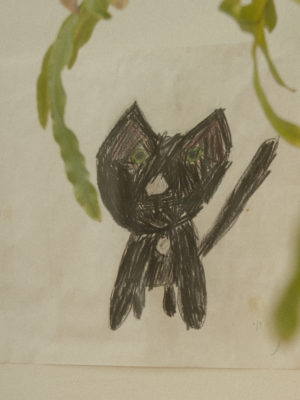
Do you have any other concepts you are currently working on?
I found mammoth ivory in Austria, where I grew up, and I’ve tried to do something with it for quite a while. It really intrigues me, but it has so many limitations. It’s definitely something I would love to try to work with next. I would like to make a series of rings, but I find it very difficult since rings are so small and singular. I think I would like to collaborate once more with Benedikt Fischer and a number of other people. I really like it when two people try to make some kind of melange of who they are, and I would like to make rings because I feel like rings speak the most about belonging.
Yes, in my opinion rings are more intimate than any other type of jewellery. You can always see a ring, and thus it constantly reminds you of something – not to mention that you are able to unconsciously fiddle and play with it.
Exactly. I remember, I had this lip piercing I would always play with; then suddenly I thought ‘Hmm, maybe I should have a ring for that.’ So, many years later, I came back to the idea.
When you are designing a new collection, do you do it with a certain vision of a possible wearer in mind?
Somewhat, and especially with rings: I make them my size and make sure they are something I would like to wear. Also, I like to make the pieces gender-neutral. I’m really lucky that many men wear my work, but I have no concept of an ‘ideal’ wearer.
Do you sometimes have those moments when you are stuck?
All the time! I hate it.
How do you fight it?
For me, creating a completely new body of work is horrifying. It’s so difficult to just flip the page and start all over again. I believe you can only solve this problem on your own behind the workbench. It’s bit of a pity that you don’t really see art jewellery out there; most of the time it’s too distant from the general public. Sometimes it helps to make something less serious, like things your family or friends would buy. Sometimes the simpler approach reaches a wider audience.
Photography by Morgane Billuart

This article is published in the OBSESSED! Jewellery Festival Paper.
OBSESSED! is a biennial jewellery festival taking place in various cities across the Netherlands. OBSESSED! unites the best jewellery-related events – museum and gallery exhibitions, talks, fairs, book presentations and artist open studios – into one intriguing programme put together by Current Obsession.
Studio 3000 Winter Salon
Morgane de Klerk, Julia Walter, Benedikt Fischer, Shota Nakamura, Lucy Sarneel
Derde Kostverlorenkade 35, Amsterdam
9-11-2019
14:00–19:00
www.obsessedwithjewellery.com/event/studio-3000-salon
